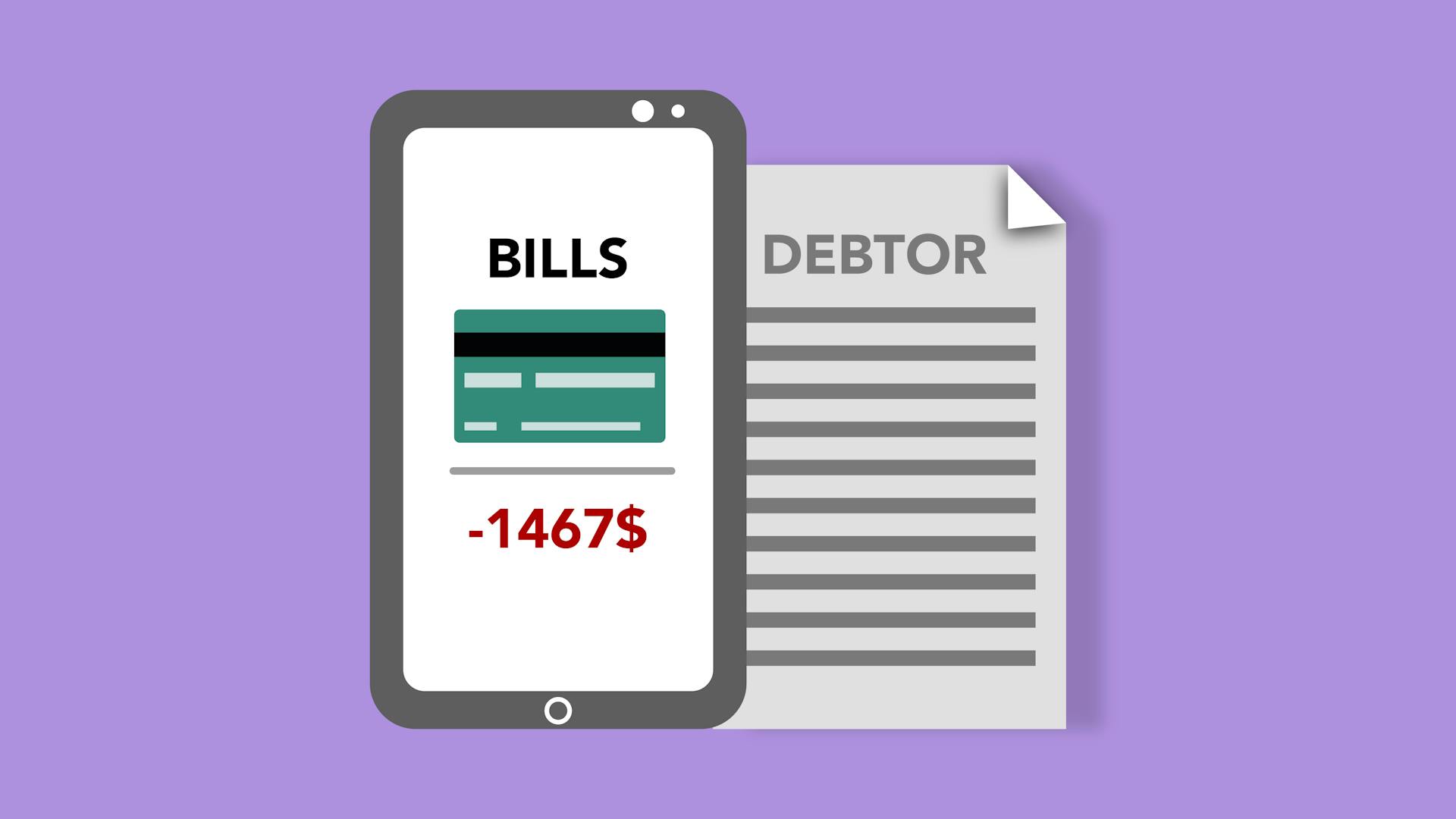
Accounting for long-term liabilities can be a complex task, but understanding the basics can make a big difference. Long-term liabilities are debts or obligations that a company expects to pay off in more than one year, such as bonds, loans, and leases.
Long-term liabilities are typically reported on a company's balance sheet and can have a significant impact on its financial statements. A company's long-term liabilities can be classified as non-current or long-term, and are typically represented by a debit balance in the liabilities section of the balance sheet.
Companies must account for long-term liabilities in accordance with accounting standards, such as GAAP or IFRS. This includes recognizing the liability on the balance sheet and providing adequate disclosure about the nature and amount of the liability.
Intriguing read: Deferred Liability
Understanding Long-Term Liabilities
A long-term liability is a financial obligation that is not due within the next 12 months or within a company's operating cycle if it is longer than one year. This can include debts such as mortgages, car payments, or other loans for machinery, equipment, or land.

Long-term liabilities are listed separately from current liabilities on a company's balance sheet and can include payments on loans, bonds, and pension liabilities not due within the next 12 months.
Some examples of long-term liabilities include the long-term portion of a bond payable, the present value of a lease payment that extends past one year, and deferred tax liabilities that typically extend to future tax years.
Other long-term liabilities are debts due beyond one year that are not deemed significant enough to warrant individual identification on a company's balance sheet and are lumped together on the balance sheet rather than broken down one by one and given an individual figure.
Types of long-term liabilities include long-term loans, lease obligations, pension obligations, deferred tax liabilities, and contingent liabilities.
Long-term debt is classified as a non-current liability on the balance sheet and may be consolidated into one line-item or broken out into separate items, depending on the company's financial reporting and accounting policies.
Here are some common types of long-term debt:
- Bank Debt – This is any loan issued by a bank or other financial institution and is not tradable or transferable the way bonds are.
- Mortgages – These are loans that are backed by a specific piece of real estate, such as land and buildings.
- Bonds – These are publicly tradable securities issued by a corporation with a maturity of longer than a year.
- Debentures – These are loans that are not backed by a specific asset and, thus, rank lower than other types of debt in terms of their priority for repayment.
Accounting for Long-Term Liabilities

A long-term liability is a debt or obligation that is due more than 12 months from the balance sheet date. Companies should classify debt as long-term or current based on facts existing at the balance sheet date rather than expectations.
To accurately account for long-term liabilities, companies must maintain accurate and up-to-date records of loan agreements, lease contracts, and pension obligations.
Companies should regularly review and assess the terms and conditions of long-term liabilities to ensure compliance and identify any potential risks or opportunities.
Developing a comprehensive debt repayment plan is crucial to meet long-term obligations and minimize financial strain.
Seeking professional advice from accountants or financial advisors can help optimize long-term liability management and explore potential tax benefits or cost-saving opportunities.
A company with current liabilities being refinanced into long-term liabilities may report current liabilities as long-term liabilities if the intent to refinance is present and evidence of refinancing has begun.
A liability that is coming due may be reported as a long-term liability if it has a corresponding long-term investment intended to be used as payment for the debt, as long as the investment has sufficient funds to cover the debt.
Readers also liked: Current Liabilities in Accounting
Analyzing and Managing Long-Term Liabilities

A company's long-term liabilities can have a significant impact on its financial performance and stability.
Financial ratios are used to examine a company's long-term liabilities, use of leverage, and ability to pay its debts. These ratios are carefully watched by both investors and company management.
Long-term debt can be covered by various activities such as a company's primary business net income, future investment income, or cash from new debt agreements.
Debt ratios compare liabilities to assets. The ratios may be modified to compare the total assets to long-term liabilities only. This ratio is called long-term debt to assets.
Conducting a thorough analysis of long-term liabilities is crucial to understand the financial impact on the company. Review the terms, interest rates, and repayment schedules of all long-term liabilities to gain a comprehensive understanding.
A cash flow projection that incorporates long-term liabilities can help identify potential cash flow gaps and enable proactive measures to address them. Create a cash flow projection that takes into account the repayment obligations of long-term liabilities.
Long-term liabilities play a significant role in financial statement analysis. Evaluating a company's financial statements, including the balance sheet, income statement, and cash flow statement, can help assess its financial performance, stability, and liquidity.
Worth a look: Debt to Income Ratio for Refinance
Debt and Leverage

Long term debt is a type of non-current liability that can be consolidated into one line-item or broken out into separate items, depending on the company's financial reporting and accounting policies.
Companies use debt to finance operations, fund expansion, and purchase assets, as it is often cheaper than equity and doesn't dilute ownership. This is known as financial leverage, which increases both the risk and the expected return on the company's equity.
The most common types of long term debt include bank debt, mortgages, bonds, and debentures. Bank debt is any loan issued by a bank or other financial institution, while mortgages are loans backed by a specific piece of real estate.
To evaluate a company's leverage, financial analysts look at ratios such as debt/equity, debt/capital, debt/assets, debt/EBITDA, and interest coverage ratio. These ratios help determine how much leverage a company has and whether it's using debt effectively.
Here are some common leverage ratios used to evaluate a company's debt:
By understanding these leverage ratios, financial analysts can determine whether a company is using debt effectively and whether it's at risk of overstretching itself financially.
What Is Debt?

Debt is essentially a loan that must be repaid, with Long Term Debt (LTD) being any amount of outstanding debt with a maturity of 12 months or longer.
Long Term Debt can have a maturity ranging from 12 months to 30+ years, and it can include various types of debt such as bonds, mortgages, bank loans, and debentures.
The types of debt that make up Long Term Debt are diverse, including bonds, mortgages, bank loans, and debentures, which can be a significant burden for a company to manage.
Long Term Debt is classified as a non-current liability on a company's balance sheet, indicating that it is not due for repayment within a short period of time.
For another approach, see: Long Term Bonds vs Short Term
Use of Leverage
Leverage is a powerful tool that companies use to finance their operations and expansion. It's essentially the use of debt to increase the expected return on equity.
Debt is often cheaper than equity, which means it's a more affordable way to raise funds. Companies can use debt to purchase assets, fund research and development, and generate working capital.
Expand your knowledge: What Is a Good Long Term Debt to Equity Ratio

The most common types of long-term debt include bank debt, mortgages, bonds, and debentures. Each type has its own characteristics, but they all share the goal of providing a return on investment.
To evaluate a company's leverage, financial analysts look at ratios such as debt/equity, debt/capital, debt/assets, debt/EBITDA, and interest coverage ratio. These ratios provide a snapshot of a company's financial health.
Here are some common leverage ratios:
Remember, leverage can be a double-edged sword. While it can increase expected returns, it also increases risk. Companies need to be careful not to overstretch themselves with too much debt, or it could cripple their finances and impact their credit scores.
Sources
- https://www.investopedia.com/terms/l/longtermliabilities.asp
- https://www.accountingcoach.com/blog/current-liabilities
- https://www.investopedia.com/terms/o/otherlongtermliabilities.asp
- https://www.larksuite.com/en_us/topics/accounting-glossary/long-term-liabilities
- https://corporatefinanceinstitute.com/resources/accounting/long-term-debt-ltd/
Featured Images: pexels.com


